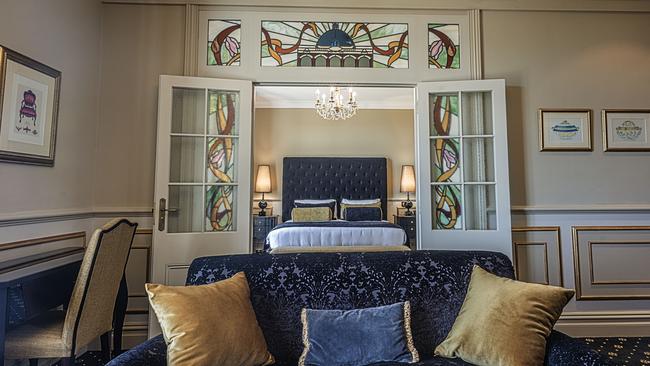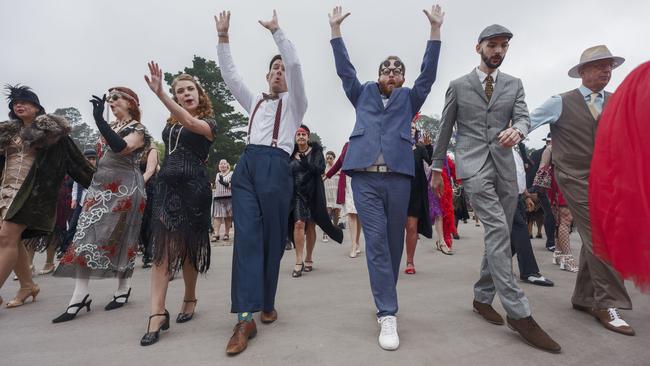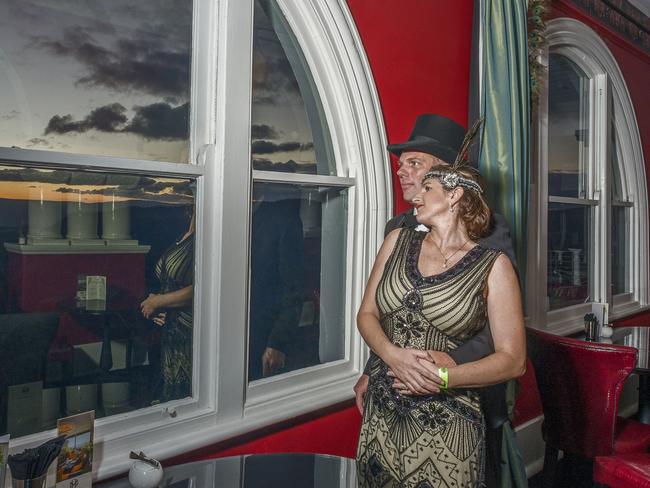Hydro therapies in the Blue Mountains
The historic Hydro Majestic Hotel in the Blue Mountains celebrates the roaring 1920s.

It’s early evening at Medlow Bath station in the Blue Mountains west of Sydney and passengers are swarming from wood-panelled carriages on a vintage train hauled by a restored 1950s diesel locomotive. It’s a stream of fringes and fedoras. One man is resplendent in a scarlet fez, while well-coiffed women sweep up the stairs in velvet cloaks. There are beaded frocks and headpieces, boaters and braces, plus jewel-coloured boas that leave a trail of feathers as the crowd weaves across the road towards the distinctive dome of The Hydro Majestic Hotel.
We are here in late February for one of the property’s best-loved annual occasions, the Hydro Express 1920s festival, a celebration of flappers, jazz and the decadent decade following the deprivations of World War I. It was a time when local and international guests flocked to the glamorous hotel to celebrate love, life, electricity (still something of a novelty) and, during its first two years, from 1904, hydropathic treatments of dubious value. There were wave baths (a rocking bathtub) and even steam boxes with head out and body in, an example of which is at the onsite Pavilion cafe, which doubles as a museum. Dame Nellie Melba and Sir Arthur Conan Doyle paid visits, the Rajah of Pudukkottai courted his soon-to-be wife, Molly Fink, and Australia’s first prime minister, Edmund Barton, died of a heart attack at the hotel in 1920. And there were dalliances aplenty, as the number of Mr and Mrs Smiths in the guest registers will attest.
The Hydro Majestic was the vision of Mark Foy of department store fame, who poured his heart, soul and ample finances into building this jewel in the mountains. Foy was also a sailor, international businessman, traveller and art buff with a love of the high life. His eclectic tastes are reflected in interiors that include art deco flourishes, art nouveau pressed-tin wall panels and ionic and corinthian columns. He enjoyed his food and guests were treated to fine fare, with produce pulled by flying fox up from his farm in the valley below. Foy was something of a marketer, too. He was able to have the village name changed from Medlow to Medlow Bath to fit his new “hydropathic establishment” and, ever the optimist, he commissioned a well at 1050m above sea level, as dry today as when the builder surrendered and laid down his tools.
After Foy died in 1950, the hotel passed through a few more owners and management operators before its purchase in 2008 by The Escarpment Group, which has refurbished and redesigned, plumped and primped, and recreated opulent spaces with a nod to Foy’s theatricality.
I pause for an aperitif in Salon Du, the former so-called Cat’s Alley, where wives and mistresses once dallied while the chaps enjoyed snooker in the adjacent room. Today it’s one of the hotel’s most inspiring spaces, with plush chrysanthemum-motif carpets in striking scarlet, silk lanterns and long velvet sofas in teal, raspberry and gold topped with brocade, and bird-patterned cushions. The curtains are trimmed with peacock feathers and walls lined with the kitsch hunting scenes of artist Arnold Zimmerman, who created the first famous smile at the entrance to Luna Park Sydney. Perched on a cliff with an outlook extending 85km over the Megalong Valley, the expansive view from Salon Du can vanish beneath dense mist or suddenly reappear in spectacular fashion.
This weekend, guests are here for the Deco Dinner, a three-course celebration of frivolity and fabulous food held in the grand ballroom and Wintergarden Restaurant. The former space is as lovely as its name suggests, with arched windows, stained-glass panels and enormous fireplaces. And as befitting its status, it’s dressed to impress tonight with white linen, sparkling glassware and lofty floral displays. There’s also a stage where long-legged models will later strut their best flapper fare. With its elegant gold and white decor, the Wintergarden is a slightly more subdued affair, perhaps a dash more Downton Abbey than Great Gatsby manor.

It wouldn’t be the 20s without some toe-tapping so we adjourn to the Boiler House, where the original immense boiler is on display behind glass. It’s now a contemporary restaurant and regular venue for visiting musicians. Jazz tunes from a live band have heads nodding and tassels swinging. In a nod to a decade far away, the final number is a from a galaxy far, far away. It’s the Cantina Band track from the Star Wars scene that introduced the world to a young Han Solo.
Accommodation is elegant across black and silver art deco-styled guestrooms with wide windows and beds laden with pillows. My heritage category chamber is smallish but larger suites are available. The deco theme extends downstairs to the Belgravia Lounge, a spacious sitting room that serves a buffet breakfast or casual tapas share-plates in the evenings.
After breakfast it’s time for a tale. For anyone intrigued by the hotel’s history, the pre-booked guided tours are a must. We meander along the collective 1.2km of the hotel spaces for stories of famous guests, aggrieved ghosts and incidents that marked Foy as a man of many quirks. The casino foyer, we learn, was built and shipped from Chicago at immense expense, after Foy took a fancy to an identical one during a stay at a hotel in the US city. The paintings in the Wintergarden, including a lovely Julian Ashton, are the remnants of a once-impressive art collection largely destroyed by a devastating fire in 1922. Foy tried to sell the hotel after the blaze but, with no bidders, poured more funds into rebuilding. The Pavilion museum cafe displays original objects that once graced the hotel, including, curiously, a confessional booth screen, perhaps favoured by some of those erring Mr and Mrs Smiths.
As the next wave of guests stream in from the Hydro Express this morning, we slip back into the Wintergarden to top off our festival weekend with a high tea. Foy frequently travelled to China, and developed a love for all things oriental so, accordingly, one of the tea options eschews finger sandwiches and scones in favour of Asian steamed dumplings, delicate savoury treats and bite-sized sweets of lemon, lavender and passionfruit.
Other events this weekend have included the Charleston Dance for Charity and a leisurely long lunch showcasing local producers. But the hotel keeps the heritage spirit alive year-round with vintage vehicle tours, picnics and teas. As we near the dawn of a new 20s decade, there are plans for an extra-special festival next year.
Sharon Dowley was a guest of The Hydro Majestic Hotel.
-
More to the story
Fans of 1930s style should consider the 2020 Napier Art Deco Festival in the NZ North Island city famous for its unified buildings and streetscapes, recreated after an earthquake in 1931. The replacement buildings reflect architectural styles of the era, including Spanish mission and art deco. The Art Deco Trust hosts daily guided walks, and the annual festival is a celebration of all things 1930s, including vintage cars, fashion and music; February 19-23, 2020.
-
In the know

The hotel has a calendar of Live@TheHydro musical events with dinner and show. Next year’s Hydro Express 1920s Festival will be held in February, exact dates to be confirmed. Accommodation packages are offered year-round. Heritage Valley View Room, from $209; hotel tour $10; vintage car tours from $295 a couple.
